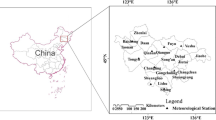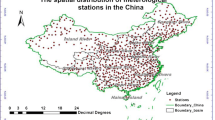Abstract
Extreme weather events include unusual, severe or unseasonal weather, and weather at the extremes of the historical distribution. They have become more frequent and intense under global warming, especially in mid-latitude areas. They bring about great agricultural and economic losses. It is important to define the threshold of extreme weather event because it is the starting point of extreme weather event research, though it has been of seldom concern. Taking extreme precipitation events in Anhui, China as an example, the detrended fluctuation analysis (DFA) method is introduced to define the threshold of extreme weather events. Based on it, the spatial and temporal distributions of extreme precipitation events are analyzed. Compared to the traditional percentile method, DFA is based on the long-term correlation of time series. Thresholds calculated by DFA are much higher than the 99th percentile and the values are higher in the south and lower in the north. This spatial pattern is similar to the annual precipitation spatial pattern. There is an obvious increasing trend in the number of days with extreme precipitation, especially after the 1980s. This observation supports the point that more extreme events happen under global warming.




Similar content being viewed by others
References
Alexander LV, Zhang X, Peterson TC et al (2006) Global observed changes in daily climate extremes of temperature and precipitation. J Geophys Res Atmos 111, D05109. doi:10.1029/2005JD006290
Bashan A, Bartsch R, Kantelhardt JW, Havlin S (2008) Comparison of detrending methods for fluctuation analysis. Physica A 387:5080–5090
Bartsch R, Plotnik M, Kantelhardt JW et al (2007) Fluctuation and synchronization of gait intervals and gait force profiles distinguish stages of Parkinson’s disease. Physica A 383(2):455–465
Bell JL, Sloan LC, Snyder MA (2004) Regional changes in extreme climate events: a future climate scenario. J Clim 17:81–87
Bunde A, Eichner JF, Kantelhardt JW, Havlin S (2005) Long-term memory: a natural mechanism for the clustering of extreme events and anomalous residual times in climate records. Phys Rev Lett 94:048701
Chen X, Lin G, Fu Z (2007) Long-range correlations in daily relative humidity fluctuations: a new index to characterize the climate regions over China. Geophys Res Lett 34, L07804
Fraedrich K (2002) Fickian diffusion and Newtonian cooling: a concept for noise induced climate variability with long-term memory? Stochast Dyn 02:403
Friederichs P (2010) Statistical downscaling of extreme precipitation using extreme value theory. Extremes 13:109–132
Hu Y, Maskey S, Uhlenbrook S (2012) Trend in temperature and rainfall extremes in the Yellow River source region, China. Clim Chang 110:403–429
IPCC (2007) Climate change 2007: the physical science basis. Contribution of Working Group Ι to the Fourth Assessment Report of the Intergovernmental Panel on Climate Change. Cambridge University Press, Cambridge, UK
Ivanov PC, Ma QD, Bartsch RP et al (2009) Levels of complexity in scale-invariant neural signals. Phys Rev E 79:041920
Jiang D, Li Z, Wang Q (2012) Trends in temperature and precipitation extremes over Circum-Bohai-Sea Region, China. Chin Geogr Sci 22(1):75–87
Kantelhardt JW, Zschiegner SA, Koscielny-Bunde E, Bunde A, Havlin S, Stanley HE (2002) Multifractal detrended fluctuation analysis of nonstationary time series. Physica A 361:87–114
Kurnaz ML (2004) Application of detrended fluctuation analysis to monthly average of the maximum daily temperatures to resolve different climates. Fractals 12:365–373
Li Z, Zheng F, Liu W et al (2010) Spatial distribution and temporal trends of extreme temperature and precipitation events on the Loess Plateau of China during 1961–2007. Quat Int 266:92–100
Ma QDY, Bartsch RP, Bernaola-Galvan P et al (2010) Effect of extreme data loss on long-range correlated and anti-correlated signals quantified by detrended fluctuation analysis. Phys Rev E 81:031101
Mirza MMQ (2003) Climate change and extreme weather events: can developing countries adapt? Clim Police 3:233–248
Peng CK, Buldyrev SV, Havlin S (1994) Mosaic organization of DNA nucleotides. Phys Rev E 49(2):1685–1689
Rahmstorf S, Coumou D (2011) Increase of extreme events in a warming world. Proc Natl Acad Sci USA 108:17905–17909
Samenow J (2011) U.S. had most extreme precipitation on record in 2011. The Washington post local. 12 January 2012
Wan Zin WZ, Jamaludin S, Deni SM, Jemain AA (2010) Recent changes in extreme rainfall events in Peninsular Malaysia: 1971–2005. Theor Appl Climatol 99:303–314
Wang Y, Zhou L (2005) Observed trends in extreme precipitation events in China during 1961–2001 and the associated changes in large-scale circulation. Geophys Res Lett 32, L09707. doi:10.1029/2005GL022574
Weron R (2002) Estimating long-range dependence: finite sample properties and confidence intervals. Physica A 312:285–299
Yang P, Hou W, Feng G (2008) Determining the threshold of extreme events with detrended fluctuation analysis. Acta Phys Sin 58:5333–5343
Yuan N, Fu Z, Li H, Mao J (2012) Effect of extreme value loss on long-term correlated time series. Theor Appl Climatol 109:133–140
Acknowledgments
This study is supported by the National Key Technology R&D Program of China under grant no. 2011BAD32B00-04, the National Grand Fundamental Research 973 Program of China under grant no. 2010CB951102, the National Natural Science Foundation of China under grant nos. 41071326 and 40871236, and the National Scientific Research Special Project of Public sectors (Agriculture) of China under grant no. 200903041.
Author information
Authors and Affiliations
Corresponding author
Rights and permissions
About this article
Cite this article
Zhang, Q., Zhang, J., Yan, D. et al. Extreme precipitation events identified using detrended fluctuation analysis (DFA) in Anhui, China. Theor Appl Climatol 117, 169–174 (2014). https://doi.org/10.1007/s00704-013-0986-x
Received:
Accepted:
Published:
Issue Date:
DOI: https://doi.org/10.1007/s00704-013-0986-x




